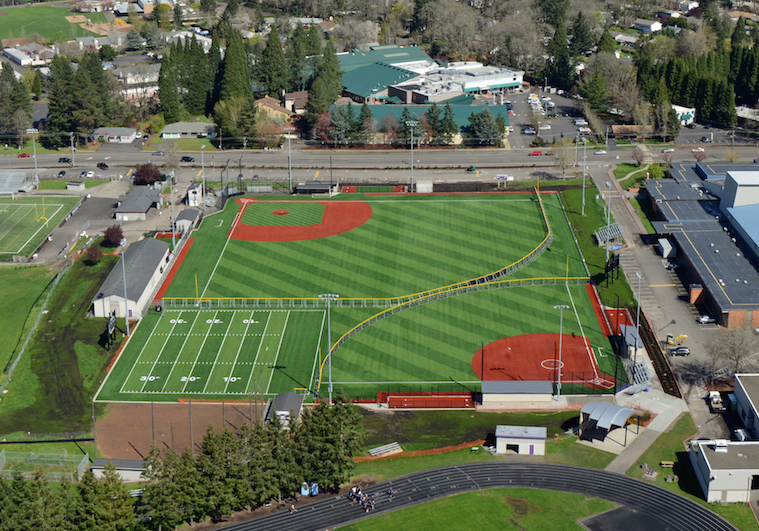There’s a scene in the movie “Animal House” where Donald Sutherland’s character stops teaching, sighs in defeat and admits to the class that he finds John Milton’s Paradise Lost as boring as they do.
A similar situation comes to mind when trying to describe drainage. It’s a core topic in the curriculum of sports fields but it’s hard to present in an exciting or enticing way. Additionally, it’s a complex topic and it’s impossible to share every piece of available information in one article. Therefore, what you’re about to get are some key facts about drainage you can take with you to the next budget meeting where you will (successfully) defend your projected expenditure. (And since the information below has been condensed from the book, Sports Fields: A Construction and Maintenance Manual, that’s where to go for the full story.)
When it comes to field planning, drainage is the most important decision you’ll make.
This is true whether you have a natural grass field or one made of synthetic turf. The success of your field, its playability, its overall look and feel—even how soon you’ll have to replace it—will all be tied into how well it drains.
Drainage is still a hard sell, however. While many people want to spend money on visible amenities like lighting and press boxes and Jumbotrons, drainage is invisible and often, there’s a strong temptation to cut back on it since ‘nobody will see it.’ But skimping on drainage doesn’t actually save money since none of the fun improvements will do you any good if the field is flooded and you can’t use it at homecoming, for instance, or that big championship.
You can’t have too much drainage. Ever heard of a field that drains too well? Neither has anyone else.
Every field needs drainage. Often, those outside the field industry (parents, your booster club, alumni, etc.) will say that having an artificial field will cut maintenance costs, and one of those costs they’ll often point to is water. But as every turf manager knows, many synthetic fields rely on constant irrigation to stay cool for comfortable play. Natural fields, conversely, may not need water to cool them, but they’ll need it to keep the grass thriving. Both types of fields, therefore, will need good drainage.
When planning a grass field, your native soil may not provide adequate drainage. On the other side of the equation is the person who declares a natural grass field is far more economical to build. In many cases, it can be, provided you have the right soil. But often, water doesn’t move very well through the soil at a given site, necessitating changes to the soil itself, resulting in additional expenses.
Traditionally, moving rainwater off the field was done by crowning and/or sloping fields; unfortunately, this may conflict with the programming requirements of the sport you’re trying to host and the level of competition the site will see. The composition of your soil can also affect its ability of soil to drain; one example is a high percentage of clay. In addition, in areas where the water table is very high, further problems may arise.
You don’t need to be an engineer to test your soil’s drainage. If you are building a natural grass field, you can do a percolation test to find out how well the site drains and the degree to which field drainage as well as site drainage will be required. To conduct such a test, dig a hole the size of a 5-gallon bucket. Fill the hole with 5 gallons of water. Allow the soil to absorb the water for an hour or two. Next, fill the hole again. It should drain completely within 24 hours. If not, at a minimum, the soil will require modification. More likely, however, a site that does not “perc” will necessitate the construction of a sand-based field and/or a more complex drainage system. A field builder will be able to examine the site and tell you more.
While synthetic fields have subsurface drainage, you’ll still need to plan appropriately. If you’re in an area that gets precipitation, you’ll need to make sure any areas adjacent to the field will shed water efficiently. The only water that lands on your field (no matter whether it’s a grass field or a synthetic field) should be coming down on it, either from precipitation or from irrigation. It should not be running onto the field from a nearby hillside or landscaping, dripping onto it from the dugout roof or running down the bleachers and onto the field. Your field should be designed so as to collect and/or redirect this water away from the field. Your field contractor will explain the various options.
The type of drainage you use will depend on your needs as well as local regulations. It’s difficult, if not impossible and impractical, to go into every type of drainage available on the market; suffice it to say there are many choices, and that these choices will need to take into consideration multiple factors, including regulatory issues. In fact, in many jurisdictions, codes require construction of a suitable storm water management and water quality system whenever a construction project covers the ground with a non-permeable surface (including, in some locales, a synthetic turf field, but also parking lots, walkways or other paved areas.) It’s another reason to engage the services of a field builder – as well as a design professional who is well versed in these issues.
Free-lancer Mary Helen Sprecher wrote this article on behalf of the American Sports Builders Association (ASBA), a non-profit association helping designers, builders, owners, operators and users understand quality construction of many sports facilities, including sports fields. One of the Association’s resources is the book, Sports Fields: A Construction & Maintenance Manual. The ASBA sponsors informative meetings and publishes newsletters, other books and technical construction guidelines for athletic facilities including running tracks and sports fields. Info: 866-501-ASBA (2722) or www.sportsbuilders.org.


